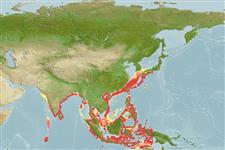Common names from other countries
>
Eupercaria/misc (Various families in series Eupercaria) >
Nemipteridae (Threadfin breams, Whiptail breams)
Etymology: Parascolopsis: Greek, para in the side of + Greek, skolos = stake + Greek, ops = appearance (Ref. 45335).
More on authors: Temminck & Schlegel.
Environment: milieu / climate zone / depth range / distribution range
экология
морской демерсальный; немигрирующий; пределы глубины 60 - 131 m (Ref. 9785). Tropical; 36°N - 12°S, 69°E - 136°E (Ref. 3810)
Eastern Indian Ocean: including the Laccadive Islands, Sri Lanka, Andaman Sea. Western Pacific: including southern Japan and the South China Sea.
Size / Вес / Возраст
Maturity: Lm ? range ? - ? cm
Max length : 18.0 cm SL самец/пол неопределен; (Ref. 3810); common length : 12.0 cm SL самец/пол неопределен; (Ref. 3810)
колючие лучи спинного плавника (общее число) : 10; членистые (мягкие) лучи спинного плавника (общее число) : 9; колючие лучи анального плавника: 3; членистые (мягкие) лучи анального плавника: 7. Head scales reaching forward to between middle of eye. Posterior margin of preopercle sloping forward slightly. Lower limb of preopercle naked. Posterior margin of suborbital fine serrate, with a very small spine at upper corner. Pectoral fins long, reaching to or beyond level of anus. Pelvic fins long, reaching to or almost to level of anus. Color: Pale yellowish body, silvery below.
Inhabits sandy or muddy bottoms in offshore waters. Usually in small groups, in depths over 50 m (Ref. 48635). Feeds mainly on benthic invertebrates. Also caught with deep-sea shrimp traps.
Life cycle and mating behavior
Maturities | размножение | Spawnings | Egg(s) | Fecundities | личинки
Russell, B.C., 1990. FAO Species Catalogue. Vol. 12. Nemipterid fishes of the world. (Threadfin breams, whiptail breams, monocle breams, dwarf monocle breams, and coral breams). Family Nemipteridae. An annotated and illustrated catalogue of nemipterid species known to date. FAO Fish. Synop. 125(12):149p. Rome: FAO. (Ref. 3810)
Статус Красного Списка МСОП (Ref. 130435)
CITES (Ref. 128078)
Not Evaluated
Угроза для людей
Harmless
Использование человеком
рыболовство: не имеет хозяйственного значения
дополнительная информация
инструменты
Специальные отчеты
Скачать в формате XML
ресурсы в Интернет
Estimates based on models
Preferred temperature (Ref.
115969): 17.8 - 27.4, mean 24 (based on 251 cells).
Phylogenetic diversity index (Ref.
82804): PD
50 = 0.5002 [Uniqueness, from 0.5 = low to 2.0 = high].
Bayesian length-weight: a=0.01349 (0.00685 - 0.02655), b=2.96 (2.80 - 3.12), in cm Total Length, based on LWR estimates for this species & (Sub)family-body (Ref.
93245).
Trophic level (Ref.
69278): 3.5 ±0.44 se; based on food items.
устойчивость к внешним воздействиям (Ref.
120179): высокий, минимальное время удвоения популяции до 15 месяцев (K=0.70).
Fishing Vulnerability (Ref.
59153): Low vulnerability (21 of 100).
